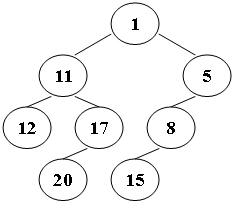Suppose that all the keys in a binary tree are distinct positive integers. A unique binary tree can be determined by a given pair of postorder and inorder traversal sequences. And it is a simple standard routine to print the numbers in level-order. However, if you think the problem is too simple, then you are too naive. This time you are supposed to print the numbers in "zigzagging order" -- that is, starting from the root, print the numbers level-by-level, alternating between left to right and right to left. For example, for the following tree you must output: 1 11 5 8 17 12 20 15.

Input Specification:
Each input file contains one test case. For each case, the first line gives a positive integer N (≤30), the total number of nodes in the binary tree. The second line gives the inorder sequence and the third line gives the postorder sequence. All the numbers in a line are separated by a space.
Output Specification:
For each test case, print the zigzagging sequence of the tree in a line. All the numbers in a line must be separated by exactly one space, and there must be no extra space at the end of the line.
Sample Input:
8
12 11 20 17 1 15 8 5
12 20 17 11 15 8 5 1
Sample Output:
1 11 5 8 17 12 20 15
#include<iostream>//根据中,后序建树,再层级遍历
#include<vector>
#include<queue>
using namespace std;
int n;
vector<int> post(30, 0), in(30, 0);
struct node{
int val;
node* left=NULL;
node* right=NULL;
node(int v):val(v), left(NULL), right(NULL){
}
};
node* buildtree(node* root, int inl, int inr, int postl, int postr){
if(inl>inr) return NULL;
root=new node(post[postr]);
int i=inl;
while(i<=inr&&in[i]!=post[postr]) i++;
int cnt=i-inl;
root->left=buildtree(root->left, inl, i-1, postl, postl+cnt-1);
root->right=buildtree(root->right, i+1, inr, postl+cnt, postr-1);
return root;
}
int main(){
cin>>n;
for(int i=0; i<n; i++)
cin>>in[i];
for(int i=0; i<n; i++)
cin>>post[i];
node* root=NULL;
root=buildtree(root, 0, n-1, 0, n-1);
queue<node*> q;
int flag=0, k=0, level=0;
q.push(root);
cout<<root->val;
while(!q.empty()){
vector<node*> v;
while(!q.empty()){
node *t=q.front();
q.pop();
if(t->left) v.push_back(t->left);
if(t->right) v.push_back(t->right);
}
for(int i = 0; i < v.size(); i++)
q.push(v[i]);
if(level % 2 == 0)
for(int i = 0; i < v.size(); i++)
printf(" %d", v[i]->val);
else
for(int i = v.size() - 1; i >= 0; i--)
printf(" %d", v[i]->val);
level ++;
}
return 0;
}